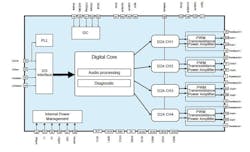Automotive Audio Amp Adds Acoustic Vehicle Alerting for Safety
A Class-D audio amplifier developed by STMicroelectronics, the HFDA801A, is targeted at automotive applications. It integrates a 24-bit, 12-dB DAC and features a 2-MHz switching PWM Class-D output stage.
This new ASIL-ready high-resolution audio amp comes with a quad-bridge configuration. The integrated DAC is designed for hi-fi quality sound under any load condition with noiseless turn-on/turn-off, and it doesn’t create output artifacts. The signal-to-noise ratio is 121 dB, dynamic range is 120 dB and output noise is 10 μV, according to the company.
The part’s feedback configuration with integrated L-C low-pass filter provides a flat frequency response up to 80 kHz and minimizes dependence on external components. It supports wide-band applications with low levels of noise and a low THD. The wide bandwidth allows its use in high-definition (HD) audio applications, enabling designers to rely on linearity and low distortion that are independent of the inductor and capacitor quality.
The specific architecture that’s implemented derives all required voltages internally, allowing the HFDA801A to draw its supply from the vehicle battery without the need for additional power converters. The amplifier is said to deliver stable performance even while driving high power on low-impedance loads of 2 Ω on all four channels.
By integrating in-play diagnostics as well as a digital impedance meter and real-time load-current monitor, the HFDA801A can be used in safety-related audio applications that must demonstrate ASIL compliance, such as acoustic vehicle alerting systems (AVAS).
It’s admittedly hard to hear electric cars driving at low speeds in front of schools, at pedestrian crossings, or traffic lights, for instance, to ensure traffic safety and to protect people, especially those who are visually impaired or rely on their hearing. AVAS is designed to emit vehicle warning sounds and alert pedestrians to the presence of these electric drive hybrids (HEVs), plug-in hybrids (PHEVs), and full-battery electric vehicles (BEVs) traveling at speeds below which the noise generated by rolling tires can be easily heard.
ST’s AVAS Automotive Class-D audio power amplifiers feature embedded diagnostics and a speaker current monitor, as well as a power-management system IC including CAN and LIN interfaces, together with the ASIL-B 32-bit MCU hosting the firmware for sound generation.
HFDA801A adopts an innovative feedback topology, where the LC filter is included in the feedback loop makes the amplifier insensitive to the characteristics of a demodulation circuit. This solution optimizes the system performance in terms of THD and frequency response in any load condition.
Regardless of the big phase shifting introduced by the output filter, the device is said to show an adequate phase margin (>45 degrees) for any working condition. The system stability has been designed considering:
- PWM switching variation (from 2.1 to 2.3 MHz)
- Silicon temperature variation (from −40 to 150°C)
- Load variation (both inductive and capacitive considered)
- LC demodulator filter variation and tolerance
- Voltage supply variation (from 4.5 to 2518 V)
- Minimum supply voltage level during turn-on transition = 5 V
The new feedback topology assures a strong control of voltage and current across the load, making the diagnostic load detection reliable.
HFDA801A was developed using BCD (Bipolar-CMOS-DMOS) technology for power ICs, which was invented by STMicroelectronics. BCD is a family of silicon processes combined onto a single chip: Bipolar for analog functions, CMOS (complementary metal-oxide semiconductor) for digital design and DMOS (double-diffused metal-oxide semiconductor) for power and high-voltage elements.
According to ST, the device offers high-quality sound at a reduced system cost. Moreover, because it supports a wide supply voltage range (from 3.3 to 18 V), it’s well-suited for any automotive audio application including standard car audio systems.
The AEC-Q100-qualified part includes full diagnostics to support OEM requirements in terms of speaker control and system robustness/reliability. It features integrated protection against overstress conditions, such as short circuits, electrostatic discharge (ESD), load dump, or overtemperature. The amplifier also supports start-stop cranking down to 4.5 V (5 V at turn-on) and is housed in a thin LQFP 10x10 package.
The HFDA801A is sampling now and will be in production in the second half of 2021.

